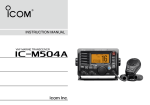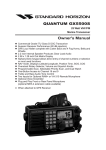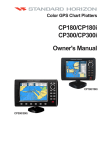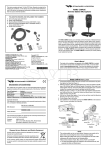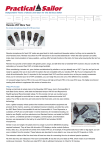Download Practical Sailor Review iM424
Transcript
iM424 HF Marine Transceiver Practical Sailor Review “Feature Loaded High-end VHFs” by Frank Lanier Testers put seven top-of-the-line VHFs through bench testing to determine which ones offer the most value for sailors. Icom’s new M424’s many features are reviewed and analyzed. www.practical-sailor.com ©2012 Icom America Inc. The Icom logo is a registered trademark of Icom Inc. 41303 Testers put seven top-of-the-line VHFs through bench testing to determine which ones offer the most value for sailors. Feature Loaded High-end VHFs Fixed marine radios priced at $300-plus offer plenty of extras. Photos by Frank Lanier T he high-end, fixed-mount marine VHF radios that Practical Sailor recently tested go way beyond the basic capabilities offered by many of the moderately priced VHF units in our June 2012 review. Standard features for this group include integral high-wattage hailers, multiple remote microphone connections, and the capability to store more Maritime Mobile Service Identity (MMSI) numbers and inbound Digital Selective Calling (DSC) data. Bonus capabilities in these top-of-the-line radios include the ability to act as part of an intercom system, to display vast amounts of navigation data, and to produce automated fog signals at the touch of a button. (See "Features 411" for a glossary of features and functions.) Taking advantage of all the features found in these top-of-the-line units often requires purchasing additional equipment—navigation data must be supplied by a compatible, onboard GPS/chartplotter; external horns must practical sailor be installed to use hailer and foghorn options; and so on. The radio itself ends up being the base for building a communications system, and buyers could spend hundreds more to fully capitalize on the capabilities of one of these multifunction marine VHF radios. Sailors who rarely use the bells-andwhistles may be better served with one of the mid-priced radios we reviewed in the June article, and bluewater cruisers might want to consider buying two budget-friendly VHFs (one to wire to a mast-top antenna and the other to a stern-rail antenna) to add redundancy and a layer of security for about the same price as one of the high-end VHFs. However, if you’re in the market for a primary VHF and have the budget for the added features, you will be well served with one of the seven following high-end radios. What We Tested During our last look at high-end VHFs (PS, October 2009), the Standard Hori- zon GX5500S took Best Choice honors and the company’s GX5000S was named Budget Buy. For our 2012 evaluation, we tested seven fixed marine VHFs priced above $300. Testers evaluated one radio from industry leader Standard Horizon, the Matrix AIS+ GX2150, and two (VHF 200 and VHF 300) from Garmin, a worldwide provider of navigation, communication, and information devices. Icom, a global manufacturer of marine and avionics communications products, provided three units for our test: the ICM424, IC-M504A, and IC-M604A. We also tested the Ray 218 from Raymarine, a world leader in marine electronics for recreational boating. All of the units in our test group are NMEA 0183 network compatible, and the two Garmin radios are also NMEA 2000 compatible. Each of the test products also featured microphones with various control options (from channel changing to channel scanning); some featured removable primary mics, which can be handy when troubleshootjuly 2012 7 electronics VA L U E g u i d e high-end fixed vhf radios Maker model Price warranty nmea compatibility mic controls* garmin Icom VHF 200 VHF 300 w/GHS remote handset $310 $546 $330 $331 $512 2 years limited (Americas, Caribbean) 2 years limited (Americas, Caribbean) 3 years 3 years 3 years NMEA 0183 NMEA 0183 NMEA 0183 NMEA 0183 & 2000 NMEA 0183 & 2000 IC-M424 IC-M504A IC-M604A 1,2,3 1,2,3,4,5,6,7 1,2,6 1,2,6 1,2,6 remote mic capable Yes (3 total) Yes Yes Yes Yes (2 total) footprint (H x W x D) 4.65 x 7.56 x 6.42 inches 7.09 x 9.75 x 2.5 inches 3.23 x 6.46 x 4.72 inches 4.33 x 6.5 x 4.27 inches 4.34 x 8.65 x 4.31 inches Display Size (H x W) 2.75 x 1.6 inch 1.63 x 1 inch (mic) 2.75 x 1.38 inch 2.75 x 1.38 inch 2.75 x 1.38 inch No No No Yes Yes 25 watts 30 watts 10 watts 25 watts 30 watts Auto Fog Yes Yes No Yes Yes Waterproof IPX7 IPX7 IPX7 IPX8 IPX7 Scrambler Hailer Test Results Audio Output (@ 3 feet) 97 decibels 83 decibels 88 decibels 84 decibels 97 decibels Transmit power (high/low at 13.8 volts) 24.8 / 1.0 watts 21.8 / .85 watts 22.2 / .81 watts 22 / .80 watts 22.5 / .81 watts transmit power (high/low at 11.8 volts) 24.2 / 1.0 watts 21.7 / .85 watts 21.5 / .76 watts 21.7 / .80 watts 21 / .80 watts power draw (high/low transmit at 13.8 volts) 4.5 / 1.2 amps 4.3 / 1.1 amps 3.0 / .4 amps 3.7 / 1.1 amps 3.9 / 1.4 amps power draw (high/low transmit at 11.8 volts) 4.7 / .5 amps 4.6 / .5 amps 3.0 / .3 amps 3.7 / .5 amps 3.5 / .7 amps Transmitter Frequency Stability Very good Very good Good Very good Excellent Receive Sensitivity Very good Excellent Very good Very good Very good Display Rating Good Good Good Good Good Audio Quality Very good Good Good Good Excellent transmit power stability Very good Excellent Excellent Excellent Good AquaQuake speaker draining feature, intercom (when coupled with optional Command Mic); rear mic connection; front panel mic not detachable. AquaQuake; intercom (when coupled with Command Mic); mic detachable; only one with keypad. comments Best Choice $ Budget Buy Position tracking; detachable mic; intercom (when coupled with GHS 10 mic); highest power output and highest amp draw. Uses Garmin GHS handset for display and control; lowest power output and lowest audio output; best receiver sensitivity. Lowest power draw, but worst frequency error of group (still within specs). Recommended * Mic controls: 1= Push to talk, 2= Channel change, 3= Quick 16/9, 4= Distress key, 5= Volume adjust, 6+ High/Low power, 7=Other 8 july 2012 www.practical-sailor.com electronics raymarine Standard horizon Matrix AIS + GX2150 $ Ray 218 $456 $340 3 years limited 3 years NMEA 0183 NMEA 0183 1,2,3,6,7 1,2,3 Yes Yes 3.84 x 7.79 x 7.06 inches 3.1 x 7.1 x 4.8 inches 2 5/8 x 1 3/8 inch 2 7/8 x 1 3/8 inch No Yes 30 watts 30 watts Yes Yes IPX7 IPX7 Test Results 89 decibels 88 decibels 22.8 / .90 watts 23.5 / .81 watts 22.8 / .90 watts 23.2 / .80 watts 3.4 / .6 amps 3.8 / 1.2 amps 3.4 / .6 amps 3.6 / .6 amps Excellent Excellent Good Very good Good Good Excellent Good Very good Very good Receiver sensitivity was lowest of group but was good and within specs. practical sailor Only unit with built-in AIS; least frequency error. ing; and all were capable of supporting remote “smart” mics. A few even supported multiple remote mics. All of the radios had channel scanning features, ranging from standard and custom memory scanning to dual watch, which monitors channel 16 every couple of seconds, and tri-watch, which monitors both 16 and 9. Each radio is also waterproof to IPX7 (can handle immersion in 3 feet of water for up to 30 minutes) or IPX8 standards (rated for continuous underwater use), and all can be interfaced with a GPS. One test unit, Standard Horizon’s Matrix GX2150, featured a built-in Automatic Identification System (AIS) receiver that displays other boats’ AIS data (including vessel name, speed, course, etc.) on a radar-like screen. Only one test radio, the IC-M604A, featured an alphanumeric keypad, which can make entering MMSI contact numbers and DSC call data faster. According to Icom Sales Manager David McLain, fewer than 5 percent of recreational boaters use DSC functions, so an alphanumeric keypad is not always considered a must-have feature. VHFs without keypads are also typically cheaper and require less mounting space; however, access to a keypad is still a valuable benefit, in our opinion. All of the test radios feature automatic fog signals via a hailer, and all have Class D DSC capabilities and operation, which means they have one receiver that monitors voice channels and another that continuously monitors channel 70 for digital DSC calls. Also, all DSC Class D radios will make distress, individual, all ships, and group calls. As noted in our June mid-priced VHF test, GPS compatibility and DSC capability are imperative for a VHF to serve its intended function: distress notification. Providing the unit with GPS data and a properly programmed Maritime Mobile Service Identity number (MMSI) for DSC operation means the boat can be more easily identified and located in an emergency. To make a distress call with a DSCequipped VHF, users simply press the well-marked, red distress button for five seconds. Once the DSC call is acknowl- edged, users would then issue a voice Mayday on VHF channel 16. Future articles will take a look at other marine communication products and accessories, including remote VHF microphones, handheld VHFs, portable sat phones, and AIS standalone units. How We Tested Practical Sailor testers ran all the radios through a series of bench tests—including transmitter power output, frequency accuracy and stability, and receiver sensitivity—using our Ramsey COM3010 service monitor. All radios in our test group met industry standards with regards to the above tests, but some did it better than others. Regulations set by the U.S. Federal Communications Commission (FCC) restrict the maximum power output of a marine VHF transmitter to 25 watts and specify the need for a low-power setting, typically 1 watt, for harbor use. Testers took transmitter power measurements directly off the VHFs’ radio antenna ports, because in any real-world scenario, factors such as antenna size and design, connecting cable length and type, or faulty connections or corrosion could limit the actual radio frequency (RF) power emitted from the antenna. Transmitter power stability was rated over a range of tests that included varying the input voltage and radio temperature. The less variation in power output, the higher the radio was rated. Frequency accuracy is the ability of the transmitter to send out signals on a selected frequency. Frequency stability measures the transmitters’ ability to maintain frequency accuracy. The FCC mandates an accuracy of 10 parts per million (about 1550 Hz off frequency). Industry groups typically call for half that error. Each unit was connected to a regulated power supply using the factory leads and appropriate crimp-on terminals. All manufacturer-supplied power leads contained a fuse holder and fuse. Power draw was recorded while transmitting at 13.8 and 11.8 volts DC, in both high and low power modes. Receiver sensitivity, the ability of the radio to hear a weak signal, is normally july 2012 9 electronics Most all VHF mics provide remote control features. The GX2150 Matrix AIS+ (#1) provides just the basics while the Garmin 300 remote mic (#2) can control all radio functions and has a display. The Raymarine 218 mic (#3) controls a number of the more common VHF functions, including channel scan. 1 and compatibility with Garmin’s GHS dards, the 200 comes with a two-year limited warranty good in the Americas 10 or GHS 10i remote microphones. Front panel controls include three and Caribbean. Bottom line: The Garmin 200 is a rotating knobs for channel selection, 2 volume, and squelch, and the channel solid radio that covers all the basics, but selector also serves as an “enter” key. The it also has the shortest and most limited stated in micro- power button does double-duty as the warranty. volts—usually from quick-select key for channel 16/9, high/ 0.22 to 0.35 micro- low power selection, DSC, menu, and Garmin VHF 300 volts for marine clear. Three soft keys below the display Unique in our test group, the 300 is esVHFs, with industry are linked to onscreen menus and pro- sentially a multi-station communicagroups recommend- vide access to functions such as screen tions “black box” that supports up to 3 ing a minimum of adjustments, navigation data configura- three Garmin GHS full-function remote 0.50. Each VHF was tion, channel group selection, channel mics. Operation of the unit is via the protested for the minimum signal it could name editing, etc. Testers found the vided GHS 10 mic, which allows full rareceive at a specific industry standard menu functions to be well-labeled and dio control from a remote location. setting between background noise and easy to use. The GHS 10 mic features a 2-inch LCD The 200 uses a monochrome dot- display. Testers noted that some sightgenerated signal. All the radios proved more than sensitive enough to pick up matrix screen to display channel num- challenged sailors might have problems weak signals within industry standards. bers, transmitter power level, selected reading the small screen, which is the VHF displays were rated on size and channel group, and channel comVHF’s only display. readability, the quality of information ments. Information too The mic also has a rolong to display in one displayed, and backlighting. tary key for frequently One very important function of the view scrolls across the used tasks and three marine VHF radio is its ability to re- bottom of the screen. soft buttons for dyproduce the sounds of incoming voice The 200 has numernamic controls. Audio communications via internal audio ous scanning opis provided by the GHS amplifier and speaker. If you can’t hear tions—normal, 10’s built-in speaker the audio, it doesn’t really matter how saved channels, and the 300’s four-inch well the transmitter or receiver works. dual watch, triactive speaker with a volGarmin 200 To rate audio systems, testers measured watch, etc.—and ume knob. A third-party the sound pressure levels at maximum also features NOAA weather alerts passive speaker could be added. volume while inputting a 1-kHz tone. and position tracking, which allows a The VHF 300 provides full NOAA The measurements were taken from 1 mariner to locate and keep tabs on up weather alerts and DSC capabilities meter away. Testers also monitored a to three other boats in the area. when interfaced with a compatible GPS The VHF 200, which features a unique chartplotter (NMEA 0183 or 2000). Its weather channel at various volume levels low-profile flush-mount, was rated Very position-tracking feature allows users to evaluate overall sound quality. Good for transmit power stability, fre- to locate and keep tabs on up to three quency stability, and receiver sensitivity. other DSC-equipped boats in the area. Garmin VHF 200 While very similar to the Garmin VHF Audio output was one of the highest of The 300 also has a two-way, 30-watt 100 unit reviewed during our June the group (97 decibels), earning a Very hailer system. Two of its most unique features are a 2012 evaluation of mid-level radios, the Good for sound quality. At 24.8 watts Garmin 300 (13.8 vDC), it had the high- voicemail function that allows users to VHF 200 brings addiest transmit power output record a 15-second voicemail message tional features to the of our test group, but con- that can be delivered to any MMSI numtable. These include versely, it also ber, and the ability to record and replay ex pa nded NM EA had the highest the last 90 seconds of any incoming voice 2000 capabilities, power draw. transmission with the touch of a button. re-locatable speaker Constructed The 300’s remote-mic setup is a good and mic, hailer and to IPX7 sta n- space-saving option, and testers liked foghorn functions, 10 july 2012 www.practical-sailor.com F e at u r e s 411 A Rundown on Common VHF Features and Functions AquaQuake: A draining function specific to Icom radios; a vibrating "buzz" clears water from the speaker grill. Noise-canceling: Reduces background noise, so you can be heard and can hear more clearly. PA/hailer and foghorn: Public address function allows users to make announcements from the mic like a loud speaker when an optional external speaker is installed. The foghorn emits horn sounds from the external speaker. Waterproof ratings: IPX7 means the VHF can handle submersion to 3 feet deep for up to 30 minutes. An IPX8 rating means the unit can handle continuous underwater use. Dual-watch scan: A channel scan mode that monitors channel 16 and another selected channel every few seconds. Tri-watch scan: Monitors both channel 16 and two other selected channels while scanning. Priority scan: Channel 16 is checked between every other channel during scan. Memory scan: All VHF channels in the VHF memory are scanned from lowest to highest. Normal scan: VHF channels are scanned in numeric order. MMSI: Maritime Mobile Service Identity number. Boats are assigned one nine-digit MMSI for all onboard equipment capable of transmitting and receiving digital signals—EPIRBs, AIS devices, DSC-capable VHFs, INMARSAT satellite terminals, etc.—and that number serves as an identifier for the boat. The boat’s emergency contact info is linked to the MMSI, so when a distress call is broadcast, the info is included in the message, giving rescue and emergency personnel accurate details of the boat. DSC: Digital Selective Calling; primarily a distress-alerting function. Users can send a pre-configured digital distress message (over channel 70) to emergency personnel and other DSC-equipped boats in their area. The message contains information about the boat and its owner, its MMSI number, the nature of the distress, and priority of the call. When a DSC radio is connected to a GPS, the Mayday includes the boat’s location. The transmission takes about one-third of a second and is automatically repeated until a rescue authority answers. Class D DSC: Class D radios have two separate receivers, one for voice communications and the second for continuously monitoring channel 70 for any DSC calls. but its limited The IC-M424 has a built-in 10-watt being able to add warranty kept amplifier that increases audio output multiple stations. it out of the for functions such as the PA and fogHow e v e r, h a vwinner’s circle horn with the addition of an external ing multiple mics Icom IC-M424 i n t h is close speaker. When connected to an external should not be conevaluation. GPS receiver, it displays time and curfused with having sysrent position. When receiving position tem redundancy since the mics depend information from another vessel, the ICon a single transceiver. The redundancy Icom IC-M424 provided by a second VHF radio might Icom bills the IC-M424 as the world’s M424 can also transfer it to a compatible be a more prudent approach than relying first fixed-mount VHF with Class D chartplotter. Other features include priority and only on remote mics for long-distance DSC and active noise canceling, a feacruisers. ture that our test setup unfortunately normal scan, dual/tri-watch monitoring function, and weather channels (with Performance-wise, the VHF 300 held didn’t allow us to try out. its own. Power and audio output was the The IC-M424 also features Icom’s alert function). When coupled with lowest of the test group, but it did have new soft-key user interface, which is in- an Icom MA-500TR Class B AIS tranthe best receiver sensitivity. Transmit tuitive, easy to use, and provides quick sponder, the IC-M424 can make calls to power stability was Excellent, while fre- access to radio functions with fewer an AIS-equipped target boat using the quency stability was Very Good. Audio button pushes than a typical menu- transponder with a few button pushes and without entering the tarquality was also rated Good. driven interface. The radio Icom IC-M504A get’s MMSI number. Users The 300 carries the same limited two- is compatible with the new simply select the AIS target year warranty as the Garmin 200. Icom CommandMicIV from the display screen, seBottom line: The 300, the most ex- (HM-195) microphone, lect the VHF channel you pensive VHF in the group, is well-built which shares the want to use, then push and offers a lot of options from both op- same soft-key user the DSC call button. erational and installation standpoints, interface. practical sailor july 2012 11 electronics 1 2 3 The test group ran the gamut as far as front panel controls—from dedicated buttons and soft keys to traditional rotary knobs. The displays on the Garmin 200 (#1), Icom 504A (#2), and Raymarine 218 (#3) all were rated Good. quest or position report functions. The received position info can be transferred to external navigation equipment. The polling (request reply) function checks whether a specific ship is within the communications range. The M504A can store up to 100 MMSI numbers and as many as 40 incoming messages. Coupled with an Icom MA500TR Class B AIS transponder, calls can be made to an AIS target using the transponder without entering the target’s MMSI number. One-button control is available for transmitter power, toggling between weather and voice channels, and making Icom IC-M504A The IC-M504A is a compact, robustly a quick channel 16/9 selection. Volume, constructed radio well suited for the ma- squelch, and channel selection are knob rine environment. It’s the only radio of controlled. Scan modes include dualour test group with a waterproof rating watch, tri-watch, normal, and priority. A low-battery icon blinks when input of IPX8 (continual submersion in conditions identified by the maker). It per- power drops below 10 volts. The M504A’s formed well compared to the other test large screen shows customizable chanradios, garnering an Excellent for trans- nel comments, time and position, fremit power stability and a Very Good for quency group, transmitter power, scan receiver sensitivity and frequency error. tag, and transmit/receive icons. The unit The MM504A can connect to one re- can accept a voice scrambler and comes mote mic and can operate as part of an with a three-year warranty. Bottom line: A good performer and intercom system. When interfaced with a compatible GPS, it will display time moderately priced, the IC-M504A offers and position data, boat course, and boat a number of useful and some unique features. It gets a solid speed. Like all DSC Class Icom IC-M604A Recommended. D radios, it will make distress, individual, all ships, and group calls. Icom IC-M604A Own ship and other ship Icom’s most soposition data can also be phisticated maexchanged easily usrine VHF radio, ing the position rethe IC-M604A, After seeing the acknowledgement “Able to comply” on the 500TR screen, users key up the VHF and talk. The IC-M424 performed well overall. It had the lowest power draw of the group and had Good transmit power stability. Both audio level and quality were rated Good. Bottom line: The IC-M424 offers very good overall performance and a long list of desirable features. We’d recommend it as an affordable VHF for those who already have an AIS or those not seeking a VHF with built-in AIS. 12 july 2012 features an alphanumeric keypad, large display, and a $512 price tag, making it the second most expensive test radio. The only test unit with a keypad, the M604A had the largest footprint. It can connect to two optional remote mics and can operate as part of an intercom system. When interfaced with a compatible GPS, the M604A will display time and position data, boat course, and boat speed. Like the M504A, it will transmit and receive position data, and can store up to 100 MMSI numbers and 40 messages. Users also can call an AIS target without entering its MMSI number when the VHF is coupled with the MA-500TR AIS transponder. The IC-M604A has the same scan modes, one-button and knob controls, low-battery warning, and displayed information as the IC-M504A. As for performance, transmit power stability was rated Good, while frequency stability and receiver sensitivity were Excellent. Audio quality was also top notch, with an output of 97 decibels, tying it with the Garmin VHF 200 as the loudest unit. Bottom line: This radio has very good overall performance and numerous user-friendly features. It gets PS’s Best Choice for a fixed VHF with a keypad. Raymarine 218 The Raymarine 218 offers a host of useful features, including a moderately sized display and a mount-anywhere microphone option. It can also connect to an optional remote mic to be operated www.practical-sailor.com electronics a closest point of ap- Conclusion as part of an intercom proach alarm. It can When it comes to full-featured fixedsystem. The stanalso output this mount VHF radios—most of which dard microphone AIS data to a offer excellent performance—the feahas buttons to concompatible trol channel selectures, price, and warranty carry more GPS cha r t- weight in our ratings. In our last test of tion, scan, transmitter Raymarine 218 plotter. Like high-end radios, DSC operation made power, local/distant receive sensitivity, and quick 16 or 9 selection. the Icom M424, t h e S t a n d a rd us lean toward units with alphanumeric The Ray 218 provides one-button Horizon MATRIX AIS + GX2150 can keypads, which makes using the DSC control for toggling between weather direct dial AIS targets, but unlike the features much easier (entering contact and voice channels, making a quick Icom, no standalone AIS unit is needed. MMSI numbers and call data is faster channel 16 or 9 selection, and select- Users simply select the AIS target via and easier with a keypad). ing menus. Volume, squelch, and chan- the soft key menu to make the call. The The advent of options like coupling nel selection are controlled via rotary Matrix’s AIS functions use the radio’s with the Icom MA-500TR Class B AIS knob. Ray 218 functions that are menu VHF antenna to receive data, so no transponder (allowing for direct calling selected include local/distant receiver special or additional antenna is needed. of AIS targets without entering the tarsetting, channel group, transmitter In addition to its 30-watt PA/loud get’s MMSI number in the VHF) allevipower, scan mode, backlighting and hailer with pre-programmed ates this concern to a degree. Keypads fog contrast, key beep, and speed unit se- signs, the durable, dieare undoubtedly useful, but they lection. appear to be going the way of cast Matrix features The 218’s phonebook will store up user-changeable the dodo, if our test group to 50 MMSI numbers, and the radio channel names, is any indication. scans channels using dual-watch, tri- optional voice (The Icom ICwatch, all channels, saved channels, scrambler, clear M604A was and priority modes. It will also store voice noise canthe only test Standard Horizon three favorite channels. When it’s in- celing speaker miVHF with a Matrix AIS GX2150 terfaced with a GPS, the 218 displays crophone, 4 . 5 -wat t keypad). time, boat position, course, and speed. audio output, NOAA weather alerts, With good performance and a numIt also has a powerful, manual or programmable scan, priority scan and ber of sought-after features (not the least automatic 30-watt hailer/foghorn. In dual watch. of which is AIS), the Standard Horizon manual mode, it sounds a 400-Hz The GX2150 is also capable of sav- GX2150 edged out the Icom IC-M504A, tone as long as the push-to-talk but- ing up to 100 waypoints, which can be Garmin 200, and IC-M424 to take our ton is pressed. Sound patterns are menu navigated to via the radio’s unique nav Budget Buy recommendation. selectable, and output volume is con- compass display that shows vessel SOG, For our top pick—based on perfortrolled by soft keys. COG, and the bearing and distance mance and features—it was a toss-up bePerformance-wise, the Ray 218 to the waypoint when connected to a tween the Raymarine 218 and the Icom ranked highly. Testers found the 218’s GPS source. The GX2150 also supports IC-M604A, so we divided the field into power output over the tested tempera- a RAM3 remote access mic, allowing keypad haves and have-nots for final ratture and voltage ranges to be Excellent. remote control of all VHF, DSC, and ings. Buyers who want the convenience of Frequency stability and audio quality hailer functions (as well as an intercom a keypad should go with the IC-M604A; also were rated Excellent, while receiver between the radio and second station those who don’t can save roughly $83 by sensitivity was Good. It comes with a microphone). going with the Ray 218. three-year limited warranty. Testers found the GX2150 to be a Bottom line: The Ray 218 offers out- solid performer. Power output over the Contacts standing performance and a long list of entire temperature and voltage ranges garmin, 913/397-8200, user-friendly features. It gets the Best was Good. Frequency stability was the www.garmin.com Choice pick for a keypad-less fixed VHF. best of the group, while receiver sensiicom america, 800/426-7983, tivity and audio quality were rated Very www.icomamerica.com Good and Good, respectively. Standard Horizon GX2150 Rated to IPX7, the GX2150 comes The GX2150 Matrix AIS+ has a built-in standard horizon, dual-channel AIS receiver that allows with a three-year warranty. 800/767-2450, Bottom line: If you’re looking for the VHF to display AIS target informawww.standardhorizon.com tion, including MMSI, call sign, ship AIS functionality combined with solid name, bearing, distance, speed over VHF performance at an affordable raymarine, 603/881 5200, ground, and course over ground, your price, the GX2150 is the one for you. www.raymarine.com vessel’s position in relation to them, and It is our Budget Buy. practical sailor july 2012 13











